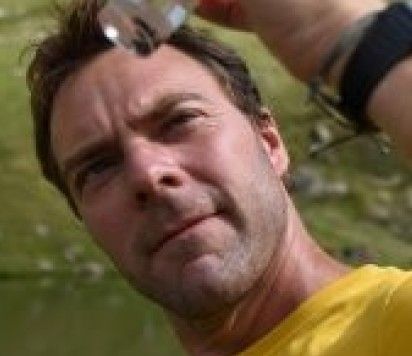Results
- Showing results for:
- Reset all filters
Search results
-
Journal articleRomo CM, Tylianakis JM, 2013,
Elevated Temperature and Drought Interact to Reduce Parasitoid Effectiveness in Suppressing Hosts
, PLOS ONE, Vol: 8, ISSN: 1932-6203- Author Web Link
- Cite
- Citations: 92
-
Journal articleEwers RM, Banks-Leite C, 2013,
Fragmentation impairs the microclimate buffering effect of tropical forests
, PLoS One, Vol: 8, Pages: 1-7, ISSN: 1932-6203BackgroundTropical forest species are among the most sensitive to changing climatic conditions, and the forest they inhabit helps to buffer their microclimate from the variable climatic conditions outside the forest. However, habitat fragmentation and edge effects exposes vegetation to outside microclimatic conditions, thereby reducing the ability of the forest to buffer climatic variation. In this paper, we ask what proportion of forest in a fragmented ecosystem is impacted by altered microclimate conditions driven by edge effects, and extrapolate these results to the whole Atlantic Forest biome, one of the most disturbed biodiversity hotspots. To address these questions, we collected above and below ground temperature for a full year using temperature sensors placed in forest fragments of different sizes, and at different distances from the forest edge.Principal FindingsIn the Atlantic forests of Brazil, we found that the buffering effect of forests reduced maximum outside temperatures by one third or more at ground level within a forest, with the buffering effect being stronger below-ground than one metre above-ground. The temperature buffering effect of forests was, however, reduced near forest edges with the edge effect extending up to 20 m inside the forest. The heavily fragmented nature of the Brazilian Atlantic forest means that 12% of the remaining biome experiences altered microclimate conditions.ConclusionsOur results add further information about the extent of edge effects in the Atlantic Forest, and we suggest that maintaining a low perimeter-to-area ratio may be a judicious method for minimizing the amount of forest area that experiences altered microclimatic conditions in this ecosystem.
-
Journal articleLedger ME, Brown LE, Edwards FK, et al., 2013,
Drought alters the structure and functioning of complex food webs
, Nature Climate Change, Vol: 3, Pages: 223-227, ISSN: 1758-678X -
Journal articleDamerell P, Howe C, Milner-Gulland EJ, 2013,
Child-orientated environmental education influences adult knowledge and household behaviour
, Environmental Research Letters, Vol: 8, Pages: 1-7, ISSN: 1748-9326Environmental education is frequently undertaken as a conservation intervention designed to change the attitudes and behaviour of recipients. Much conservation education is aimed at children, with the rationale that children influence the attitudes of their parents, who will consequently change their behaviour. Empirical evidence to substantiate this suggestion is very limited, however. For the first time, we use a controlled trial to assess the influence of wetland-related environmental education on the knowledge of children and their parents and household behaviour. We demonstrate adults exhibiting greater knowledge of wetlands and improved reported household water management behaviour when their child has received wetland-based education at Seychelles wildlife clubs. We distinguish between 'folk' knowledge of wetland environments and knowledge obtained from formal education, with intergenerational transmission of each depending on different factors. Our study provides the first strong support for the suggestion that environmental education can be transferred between generations and indirectly induce targeted behavioural changes.
-
Journal articleMilner-Gulland EJ, Barlow J, Cadotte M, et al., 2013,
Celebrating the golden jubilee of the Journal of Applied Ecology
, JOURNAL OF APPLIED ECOLOGY, Vol: 50, Pages: 1-3, ISSN: 0021-8901- Author Web Link
- Cite
- Citations: 2
-
Journal articleGallego-Sala AV, Prentice IC, 2013,
Blanket peat biome endangered by climate change
, NATURE CLIMATE CHANGE, Vol: 3, Pages: 152-155, ISSN: 1758-678X- Author Web Link
- Cite
- Citations: 106
-
Journal articleLaliberte E, Lambers H, Norton DA, et al., 2013,
A long-term experimental test of the dynamic equilibrium model of species diversity
, OECOLOGIA, Vol: 171, Pages: 439-448, ISSN: 0029-8549- Author Web Link
- Cite
- Citations: 21
-
Journal articleLayer K, Hildrew AG, Woodward G, 2013,
Grazing and detritivory in 20 stream food webs across a broad pH gradient.
, Oecologia, Vol: 171, Pages: 459-471Acidity is a major driving variable in the ecology of fresh waters, and we sought to quantify macroecological patterns in stream food webs across a wide pH gradient. We postulated that a few generalist herbivore-detritivores would dominate the invertebrate assemblage at low pH, with more specialists grazers at high pH. We also expected a switch towards algae in the diet of all primary consumers as the pH increased. For 20 stream food webs across the British Isles, spanning pH 5.0-8.4 (the acid sites being at least partially culturally acidified), we characterised basal resources and primary consumers, using both gut contents analysis and stable isotopes to study resource use by the latter. We found considerable species turnover across the pH gradient, with generalist herbivore-detritivores dominating the primary consumer assemblage at low pH and maintaining grazing. These were joined or replaced at higher pH by a suite of specialist grazers, while many taxa that persisted across the pH gradient broadened the range of algae consumed as acidity declined and increased their ingestion of biofilm, whose nutritional quality was higher than that of coarse detritus. There was thus an increased overall reliance on algae at higher pH, both by generalist herbivore-detritivores and due to the presence of specialist grazers, although detritus was important even in non-acidic streams. Both the ability of acid-tolerant, herbivore-detritivores to exploit both autochthonous and allochthonous food and the low nutritional value of basal resources might render chemically recovering systems resistant to invasion by the specialist grazers and help explain the sluggish ecological recovery of fresh waters whose water chemistry has ameliorated.
-
Journal articleMurray SJ, Watson IM, Prentice IC, 2013,
The use of dynamic global vegetation models for simulating hydrology and the potential integration of satellite observations
, PROGRESS IN PHYSICAL GEOGRAPHY-EARTH AND ENVIRONMENT, Vol: 37, Pages: 63-97, ISSN: 0309-1333- Cite
- Citations: 34
-
Journal articleHarrison SP, Morfopoulos C, Dani KGS, et al., 2013,
Volatile isoprenoid emissions from plastid to planet
, NEW PHYTOLOGIST, Vol: 197, Pages: 49-57, ISSN: 0028-646X- Author Web Link
- Cite
- Citations: 121
-
Journal articleClements T, Rainey H, An D, et al., 2013,
An evaluation of the effectiveness of a direct payment for biodiversity conservation: The Bird Nest Protection Program in the Northern Plains of Cambodia
, BIOLOGICAL CONSERVATION, Vol: 157, Pages: 50-59, ISSN: 0006-3207- Author Web Link
- Cite
- Citations: 40
-
Journal articleLavandero B, Tylianakis JM, 2013,
Genotype matching in a parasitoid-host genotypic food web: an approach for measuring effects of environmental change
, MOLECULAR ECOLOGY, Vol: 22, Pages: 229-238, ISSN: 0962-1083- Author Web Link
- Cite
- Citations: 17
-
Journal articleHudson LN, Emerson R, Jenkins GB, et al., 2013,
Cheddar: analysis and visualisation of ecological communities in R
, METHODS IN ECOLOGY AND EVOLUTION, Vol: 4, Pages: 99-104, ISSN: 2041-210X- Author Web Link
- Cite
- Citations: 78
-
Journal articleSutherland WJ, Freckleton RP, Godfray HCJ, et al., 2013,
Identification of 100 fundamental ecological questions
, JOURNAL OF ECOLOGY, Vol: 101, Pages: 58-67, ISSN: 0022-0477- Author Web Link
- Cite
- Citations: 546
-
Journal articlePearse WD, Jones FA, Purvis A, 2013,
Barro Colorado Island’s phylogenetic assemblage structure across fine spatial scales and among clades of different ages
, Ecology, Vol: 94, Pages: 2861-2872 -
Journal articlePearse WD, Purvis A, 2013,
phyloGenerator: an automated phylogeny generation tool for ecologists
, Methods in Ecology and Evolution, Vol: 4, Pages: 692-698 -
Journal articleCharman DJ, Beilman DW, Blaauw M, et al., 2013,
Climate-related changes in peatland carbon accumulation during the last millennium
, BIOGEOSCIENCES, Vol: 10, Pages: 929-944, ISSN: 1726-4170- Author Web Link
- Cite
- Citations: 237
-
Journal articleBragg FJ, Prentice IC, Harrison SP, et al., 2013,
Stable isotope and modelling evidence for CO<sub>2</sub> as a driver of glacial-interglacial vegetation shifts in southern Africa
, BIOGEOSCIENCES, Vol: 10, Pages: 2001-2010, ISSN: 1726-4170- Author Web Link
- Cite
- Citations: 29
-
Journal articleHowe C, Milner-Gulland EJ, 2013,
Response to Cunningham, S. and King, L. (2013)
, Animal Conservation, Vol: 16, Pages: 139-140 -
Book chapterJohnson LR, Lafferty K, McNally A, et al., 2013,
Mapping the Distribution of Malaria: current methods and considerations
, Infectious Disease Modelling, Hoboken, N.J., Publisher: Wiley-Interscience, Pages: In Press-In Press -
Journal articleKelley DI, Prentice IC, Harrison SP, et al., 2013,
A comprehensive benchmarking system for evaluating global vegetation models
, BIOGEOSCIENCES, Vol: 10, Pages: 3313-3340, ISSN: 1726-4170- Author Web Link
- Cite
- Citations: 102
-
Book chapterSt John FAV, Keane AM, Milner-Gulland EJ, 2013,
Effective conservation depends on understanding human behaviour
, Key Topics in Conservation Biology 2, Editors: Macdonald, Willis, Publisher: John Wiley & Sons, Ltd, ISBN: 978-0-470-65875-8 -
Journal articleWang H, Prentice IC, Ni J, 2013,
Data-based modelling and environmental sensitivity of vegetation in China
, BIOGEOSCIENCES, Vol: 10, Pages: 5817-5830, ISSN: 1726-4170- Author Web Link
- Cite
- Citations: 24
-
Journal articleWatson C, Mourato S, Milner-Gulland EJ, 2013,
Uncertain Emission Reductions from Forest Conservation: REDD in the Bale Mountains, Ethiopia
, ECOLOGY AND SOCIETY, Vol: 18, ISSN: 1708-3087- Author Web Link
- Cite
- Citations: 15
-
Journal articleUkkola AM, Prentice IC, 2013,
A worldwide analysis of trends in water-balance evapotranspiration
, HYDROLOGY AND EARTH SYSTEM SCIENCES, Vol: 17, Pages: 4177-4187, ISSN: 1027-5606- Author Web Link
- Cite
- Citations: 53
-
Book chapterStewart RIA, Dossena M, Bohan DA, et al., 2013,
Mesocosm Experiments as a Tool for Ecological Climate-Change Research
, ADVANCES IN ECOLOGICAL RESEARCH, VOL 48: GLOBAL CHANGE IN MULTISPECIES SYSTEMS, PT 3, Editors: Woodward, OGorman, Publisher: ELSEVIER ACADEMIC PRESS INC, Pages: 71-181, ISBN: 978-0-12-417199-2- Author Web Link
- Cite
- Citations: 210
-
BookO'Gorman EJ, Woodward G, 2013,
Editorial Commentary: Monitoring, Manipulation and Modelling of Ecological Responses to Global Change in Multispecies Systems PREFACE
, Publisher: ELSEVIER ACADEMIC PRESS INC, ISBN: 978-0-12-417199-2- Author Web Link
- Cite
- Citations: 1
-
Book chapterLedger ME, Brown LE, Edwards FK, et al., 2013,
Extreme Climatic Events Alter Aquatic Food Webs: A Synthesis of Evidence from a Mesocosm Drought Experiment
, ADVANCES IN ECOLOGICAL RESEARCH, VOL 48: GLOBAL CHANGE IN MULTISPECIES SYSTEMS, PT 3, Editors: Woodward, OGorman, Publisher: ELSEVIER ACADEMIC PRESS INC, Pages: 343-395, ISBN: 978-0-12-417199-2- Author Web Link
- Cite
- Citations: 44
-
Journal articleKross SM, Tylianakis JM, Nelson XJ, 2013,
Diet composition and prey choice of New Zealand falcons nesting in anthropogenic and natural habitats
, NEW ZEALAND JOURNAL OF ECOLOGY, Vol: 37, Pages: 51-59, ISSN: 0110-6465- Author Web Link
- Cite
- Citations: 11
-
Journal articleFoley AM, Dalmonech D, Friend AD, et al., 2013,
Evaluation of biospheric components in Earth system models using modern and palaeo-observations: the state-of-the-art
, BIOGEOSCIENCES, Vol: 10, Pages: 8305-8328, ISSN: 1726-4170- Author Web Link
- Cite
- Citations: 8
This data is extracted from the Web of Science and reproduced under a licence from Thomson Reuters. You may not copy or re-distribute this data in whole or in part without the written consent of the Science business of Thomson Reuters.
The Story of Silwood Park
Dive into the last 75 years of world-leading research in ecology, evolution and conservation at Silwood Park in our new Story.

